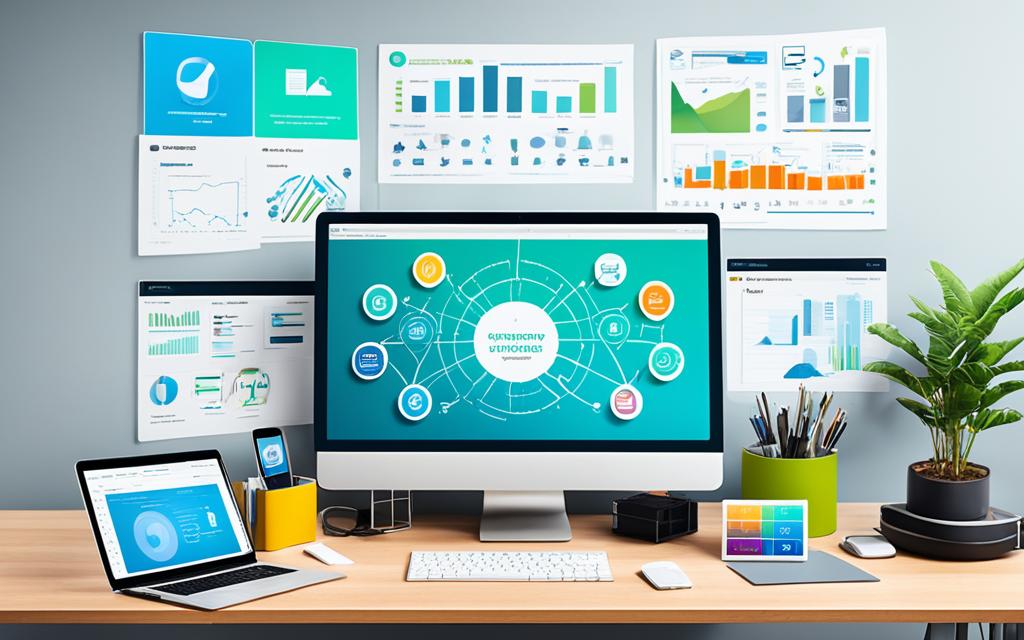Application software assist individuals and businesses in a wide range of tasks.
From boosting productivity to enhancing creativity and enabling effective communication, application software are designed to meet specific needs.
Examples of application software include popular programs like Microsoft Office, which consists of Word, Excel, PowerPoint, and Outlook. These tools help with document creation, data analysis, presentations, and email management.
Web browsers like Firefox, Chrome, Safari, and Internet Explorer are another type of application software that enables us to explore the vast world of the internet.
For music lovers, music streaming apps like Pandora, Apple Music, and Spotify offer a vast library of songs for entertainment on the go.
Communication tools such as Slack, Skype, Zoom, and Teams facilitate seamless collaboration and effective communication within teams and organizations.
When choosing application software, it’s important to consider factors like customization options, the software’s ability to automate manual processes and provide services, and the ease of connecting with others.
Now that we have a glimpse of the examples of application software, let’s dive deeper into understanding the ins and outs of this integral part of our digital lives!
Understanding Application Software
Application software are fundamental components of computer systems that are specifically designed to perform specific functions.
They can be categorized into two main types: general application software and business application software.
General Application Software
General application software addresses a wide range of user needs and encompasses various tools and programs.
Here are some examples of general application software
Word processing software: Examples include Microsoft Word and Google Docs, allowing you to create and edit documents.
Spreadsheet software: Microsoft Excel and Google Sheets are widely used for organizing and analyzing data.
Presentation software: Microsoft PowerPoint and Google Slides enable you to create visually engaging slideshows.
Web browsers: Google Chrome, Mozilla Firefox, and others provide access to the internet and web-based applications.
Graphics software: Adobe Photoshop and GIMP are popular tools for editing and creating digital graphics.
Multimedia software: VLC Media Player and Adobe Premiere Pro offer playback and editing capabilities for various multimedia files.
Educational software: Duolingo and Khan Academy provide interactive learning experiences for different subjects.
Entertainment software: Platforms like Steam and Netflix offer a wide range of games and media content for leisure.
Business Application Software
Business application software are specifically designed to streamline processes and enhance productivity in a business environment. Here are some examples of business application software:
CRM software: Salesforce and HubSpot CRM help manage and analyze customer relationships and interactions.
ERP software: SAP ERP and Oracle ERP Cloud assist in integrating and managing business processes and data.
Project management software: Trello and Asana aid in planning, organizing, and tracking project tasks.
Accounting software: QuickBooks and Xero simplify financial management and bookkeeping processes.
It’s important to note that application software should not be mistaken for system software, which includes operating systems and utilities that enable application software to run smoothly.
Customized Application Software
Customized application software are built to meet specific requirements and are tailored to the unique needs of a business. They can be developed from scratch or customized based on existing software.
These software allows businesses to have complete control over the functionalities and features they need, ensuring optimal efficiency and effectiveness.
Things To Consider When Choosing An Application Software
When it comes to selecting the right application software for your needs, there are several factors to consider.
By taking these factors into account, you can ensure that the software you choose aligns with your requirements and provides the functionality, support, and scalability you need.
1. Needs Assessment
Before making a decision, conduct a thorough needs assessment. Identify the problem the software should solve, the tasks and processes it will impact, and the target user.
This will help you understand the specific functionalities and features you require from the software.
2. Functionality
Consider the functionality needed to accomplish your tasks effectively.
Evaluate whether the software includes the necessary tools, features, and capabilities to support your processes and improve productivity.
3. Implementation Process and Support Options
Assess the implementation process to ensure a smooth transition and integration with your existing systems. Additionally, explore the support options provided by the software vendor.
Look for comprehensive documentation, training resources, and responsive customer support to assist you in case of any issues.
4. Compatibility with IT Infrastructure
Ensure that the application software is compatible with your existing IT infrastructure.
Consider factors such as operating system requirements, hardware compatibility, and integration capabilities with other software and tools you use.
5. Global Expertise
If your business operates globally or plans to expand internationally, it’s essential to consider the software vendor’s global expertise.
Look for a vendor with a strong presence and a track record of delivering reliable and localized solutions across different regions.
6. Pricing and Return on Investment
Take into account the pricing structure of the software. Evaluate whether the cost aligns with your budget and compare it with the return on investment you expect to gain from implementing the software.
Consider factors such as licensing fees, maintenance costs, and potential savings or revenue enhancements.
7. Implementation Approach and Scalability
Decide on the implementation approach that best suits your business requirements. Consider whether a phased approach or an all-at-once implementation is more suitable.
Additionally, evaluate the scalability of the software. It should have the flexibility to grow and adapt as your business evolves.
8. Custom Application Software
If your business has specific requirements that cannot be met by off-the-shelf solutions, consider the cost of developing custom application software.
While custom software can provide tailored solutions, it may come with higher development and maintenance costs.
By considering these factors and conducting a thorough evaluation, you can confidently choose the right application software that aligns with your needs, provides the necessary functionality, and offers a solid return on investment.
Conclusion
Application software greatly improve productivity and simplify tasks for personal, educational, and business purposes.
With a wide range of available examples, from word processors to CRM and ERP systems, there is software to meet the needs of every user.
When selecting the right application software, it is essential to consider factors such as functionality, implementation process, support options, scalability, and cost.
By understanding the different types of application software and their functions, individuals and businesses can make well-informed decisions to optimize their productivity and efficiency.











